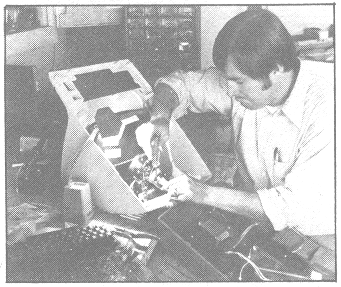Lear Siegler became the first major peripherals manufacturer to enter the fast-growing computer hobbyist market by introducing a do-it-yourself assembly kit for its ADM-3 "Dumb Terminal." Priced at $875 (as opposed to $1,280 for a factory-assembled model), the Dumb Terminal kit gives the builder a full 24-line, 12-inch screen capable of displaying 1,820 characters at 80 per line. The standard set is 64 ASCII characters generated in a 5x7 dot matrix displayed as uppercase, plus punctuation and control.
 Kit comes with two basic assemblies: the CRT section which is premounted
in the cabinet and the display electronics section, with keyboard control
and power supply also pre-mounted. Lear Siegler has simplified assembly
for the build with a building-block approach by providing the PC board
with sockets ready for easy installation of all integrated circuits.
Owners will connect the Dumb Terminal to their own micro or mini. Or,
using an acoustic coupler, call a remote computer and transform their
setup into a home grown data processing center. Purchased software games,
such as Star Trek, will take on a new light when displayed on the Dumb
Terminal screen. The ADM-3 will also directly replace a teletypewriter,
offering software compatibility through both a switch selectable 20 mA
current loop interface and the EIA standard RS232C interface for direct
connection to the conventional computer port. Data is entered via
the Dumb Terminal's 59 keyboard keys and is displayed at the bottom line
of the screen. Advancing to a new line casuses the entire page to scroll
upward, typewriter style. Full keyboard control of the display is
provided by keys for Clear Screen, Carriage Return, Line Feed, Space Bar,
Backspace, and Character Overwrite keys. End of line is announced by an
audible tone. Either full- or half-duplex operating mode is
switch-selectable as is a synchronous transmission of 7- or 8-bit ASCII
characaters, with speed ranging from 75, through 110, 150, 300, 600,
1200, 1800, 2400, 4800, 9600 to 19,200. Word format can be chosen
from 9-, 10-, or 11-bit words with odd, even or no parity, plus one or
two stop bits. For more information, write to Lear Siegler, Inc.,
EID/Data Products Group, 714 North Brookhurst Street, Anaheim, CA 92803.
Kit comes with two basic assemblies: the CRT section which is premounted
in the cabinet and the display electronics section, with keyboard control
and power supply also pre-mounted. Lear Siegler has simplified assembly
for the build with a building-block approach by providing the PC board
with sockets ready for easy installation of all integrated circuits.
Owners will connect the Dumb Terminal to their own micro or mini. Or,
using an acoustic coupler, call a remote computer and transform their
setup into a home grown data processing center. Purchased software games,
such as Star Trek, will take on a new light when displayed on the Dumb
Terminal screen. The ADM-3 will also directly replace a teletypewriter,
offering software compatibility through both a switch selectable 20 mA
current loop interface and the EIA standard RS232C interface for direct
connection to the conventional computer port. Data is entered via
the Dumb Terminal's 59 keyboard keys and is displayed at the bottom line
of the screen. Advancing to a new line casuses the entire page to scroll
upward, typewriter style. Full keyboard control of the display is
provided by keys for Clear Screen, Carriage Return, Line Feed, Space Bar,
Backspace, and Character Overwrite keys. End of line is announced by an
audible tone. Either full- or half-duplex operating mode is
switch-selectable as is a synchronous transmission of 7- or 8-bit ASCII
characaters, with speed ranging from 75, through 110, 150, 300, 600,
1200, 1800, 2400, 4800, 9600 to 19,200. Word format can be chosen
from 9-, 10-, or 11-bit words with odd, even or no parity, plus one or
two stop bits. For more information, write to Lear Siegler, Inc.,
EID/Data Products Group, 714 North Brookhurst Street, Anaheim, CA 92803.